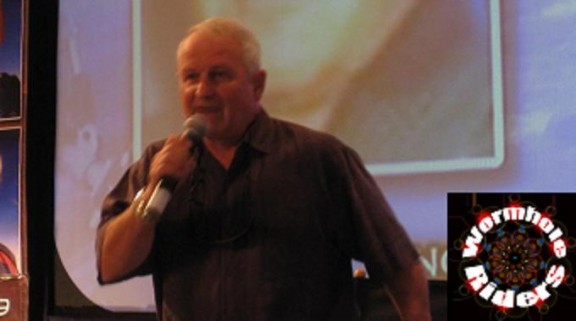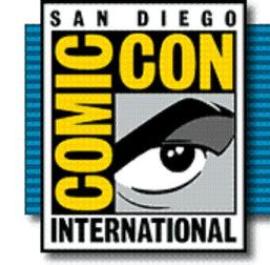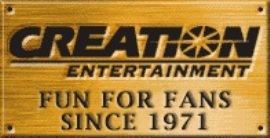We’ve seen him on camera only once, but without him there might never have been a camera in the first place! He was a producer for SG-1 from 1997-2000 (37 episodes), a co-executive producer from 2000-2006 (128 episodes) and executive producer for SG-1’s final season. He was an executive producer for Ark of Truth, and also for Atlantis for the three years it ran alone (2006-2009, 60 episodes). What does he do now? He’s an executive producer for Sanctuary, of course! Where would we be without N. John Smith?
Creation sure knows how to save the best for last! It’s Sunday of convention weekend, and it’s my last day. One day remains, but only for those holding location tour tickets for Monday morning, and I had taken the tour on Wednesday.
I honestly don’t know for sure what N. John Smith goes by for short, so I’m going to guess John and hope he’ll pardon me if I am incorrect.
John was excellent at answering our questions, even the ones he couldn’t answer definitively, and he was very patient with our persistence. In a couple cases he had to tell us that we needed to put the question to Brad Wright and Robert Cooper, who were to be our next guests! Because of that, I did conserve my writing hand because I knew that Brad and Robert would have all the latest that I would need to take down to the best of my ability.
The first question involved the timetable for the first Atlantis movie. “I’m quite sure it’s not green-lit yet, but we talk about it on a regular basis. I’m quite sure we’d all like to do it, but right you might get more clarification from Brad and Robert when they’re on a little later today. But right now I think it’s a matter of economy and the economics time we’re having, so that’s a large capital outlay, and I’m sure MGM would love to do it, but until they know that they can get a good return on their money in a fairly prompt fashion . . . I’m sure they’d like to do it, but to my knowledge it’s not green-lit. We talked about doing it this Spring, and the economy is what’s holding it back right now, but we of course want to do it (laughing) while the actors still look like they did on the series! But they’re all young guys and I’m sure they’re all interested in doing it. Did you talk to Joe [Flanigan] when he was here? Yes, so I hope to be able to do it, but again Brad and Robert might be able to answer that question better than I can, I don’t know.”
Next, John was asked about the next SG-1 movie, which if I remember correctly, had been announced by GateWorld as being green-lit by MGM just a couple of days before the convention. John said, “To my knowledge that movie has been green-lit. Again, ask Brad and Robert, but that movie was green-lit. I think the decision now is, because when we do two things at the same time like we did Atlantis and SG-1, it’s a big drain on your time, for starters. We’re all working about 20 hour days. So I think that to get a better product, and production always wants to give you guys the best product, it would probably make a lot of sense to shoot it right after we wrap the new series at the end of the season, and that way we have the full attention of James [Robins, set designer], Robert, and all our keys. We’d just roll our keys into the new project. But there was talk about doing it again this Spring and overlapping it like before, and we could do that too, so those are questions that I – I talked to Brad about it on Monday and like I say, it’s green-lit to do it, but when, I’m not sure when, but it will happen.”
Tell us about your job. “Usually, some of us get the concept scripts so it’s maybe like a five or six page outline of the acts. We talk about scripts five or six episodes ahead so that I can line locations up. There was a time when we were doing SG-1 earlier, that in February and March, we had all out locations booked right until August of that season, which is sort of unheard of for a television show. Our writing staff is really on top of things. Brad and Robert make sure that the concepts are out so that James Robins can design the sets, and we literally have to start building some of these sets five episodes before we shoot them. For instance, when we go on summer hiatus this year, and we’re off for a month, we have to be building the sets we’re going to be shooting five episodes onto it when we come back. Those sets have to be – the concepts of, the design built, and some of the props have to be manufactured. So the normal chain of events would be that we talk about it. Brad would walk in and say, ‘can we do this? What’s the possibility of finding this location?’ We never say no, we always find something. We try to keep ‘no’ out of the dialog, at least early in the stages.
“We research the location through the location manager. I’m lucky that I’ve worked in the city as long or longer than anyone else, so I kind of understand where most of the locations are. So we look and the script and say, ‘well this would be a perfect location. Let’s try and get this building, here. The location manager might have a really good idea of where to go’. Then we try to book the locations and we start building stuff. We start readings right away. We meet with the art department and say, ‘here’s a script coming up that we’ve got some real problems for. We have to build prosthetics or we have to design something’ – because you don’t just build a prosthetic for whatever, because a written Wraith prosthetic takes a good time to build it. So we have to be prepared to do that. So my job is to kind of read that, budget for it, get an idea of what it’s going to cost, like I can go in and tell the writers pretty early on, ‘this one looks like it’s going to be 2 or $3,000 over our pattern budget’ which is not unheard of, we do that all the time. I think I’ve said to you guys before, the mandate for us is, MGM is very gracious, they give us a lot of money, and we don’t have to be on the exact number for every episode, but we make some big episodes and offset them with some small episodes. The ways we do that, we’re budgeted on Atlantis and SG-1 most years for seven days, we had one year we were budgeted for six. We budget a lot of money. We have a draw-down fund for second unit, so what we normally do in order to make the shows big, it’s sometimes more economical to shoot second unit alongside main units. I can do I season unit day for $20,000 labor, versus a main unit day for $80,000. So we have all kinds of ways to try to offset overages, and bottom line is we’re all trying to put as much of the look of the show on the scene, and everybody really tries hard to get the best production value we possibly can.
“So we start meetings right away, and then a week before – as you guys know we rotate directors all the time – we can talk with the directors. Like I’ll get a script that I know Martin Wood or Andy Mikita is going to direct, or we give some guys from back East a couple episodes a year because they understand the show, and we talk to them. We send them a draft of the script and try to give everybody as much information as we possibly can so that they don’t walk into the situation cold. By the time we actually start officially prepping the episode, we all know it intimately. Usually James and I would be out looking at locations up to a month, month and a half ahead of time, and we book those locations. We’re always lucky because we have scripts, and I know lots and I have worked on productions for production companies where I’ve actually not had the script. I’ve had the meetings and gone on location scouts and not had the script. I’ve had the verbal, ‘this is what it is’, but that’s not unheard of. It happens a lot in television. A feature film is a little different. But there’s all kinds of days on sets on a lot of productions, and you name it, it doesn’t matter how big they are, but there’s actually changes of dialog coming in five minutes before that actor is shooting the script. All of a sudden he’s got a whole dialog speech that he’s got to memorize right now and learn. That doesn’t happen on Stargate. Our writers are on top of it. When there’s a rewrite, it’s done, it’s handed out, and everybody gets it ahead of time. The writing staff is unbelievable. For thirteen years it’s been that way, and we always know what we’re doing the next day, there’s never any doubt, and that really makes my job simple.”
Tell us about the casts. “You can see when I cast melds together, and it usually takes a couple of episodes for that to happen, but over the years I’ve seen that happen. Richard Dean Anderson had some people he really liked to work with. A fellow by the name of Tom McBeath [Maybourne!] was one of Rick’s favorite counterparts, so they used to act and have a lot of fun together. You can see a certain amount of magnetism between a cast right away, and in Vancouver even though there is a large cast here, a lot of people you end up working with over the years, and with a show that runs as long as Stargate, we’ve recast some of the same people for different parts, as you guys probably recognize. But you do get a report, and with some actors when you see that happen, the writers will say, ‘well this is really interesting. Maybe we’ll bring that guy back. We’ll rewrite him in another episode’ because that magnetism is there. I could see it happening with Stargate right away. Amanda [Tapping] is a great person to work with, and she’s got that twinkle in her eye, as you all know. Scenes with her and Rick were great and with Michael [Shanks] and Chris [Judge], they all became really really really good friends. When the show was actually cancelled they all got together and the cast went down to the gateroom and we let them have the gateroom, and they were there for a couple of hours just talking about it. So it was very emotional relationships built up over the years not only with the cast, but with the crew and cast. We spend upwards of anywhere from 12 to 15 hours a day working together, so you’re actually with the people you’re working with more than you’re really seeing your folks at home. So you form relationships. When we’ve had wrap parties at the end of the season sometimes they get really emotional but it was great with Stargate because we always knew – partway through year one we knew we had year two, and partway through year two we had up to four years – so you invest an interest in working with people for a long time and it really is kind of fun and the relationships build up and there’s some terrific friendships.
“I mentioned to some of the people on the tour that I was with that there are 22 people on the crew today that were here on day one of SG-1, which is really an incredible record. But with casts and magnetism, it works or it doesn’t work, and a lot of times actors can pull things off and they walk off the show and they won’t even talk to the person they were with, but I haven’t seen that happen on Stargate. Most times with SG-1 and Atlantis the casts get along really well. I used to take them out for dinner all the time and that was a lot of fun for me to see them on a different level. The last year of Atlantis, Joe and I used to go out quite a lot for dinner. We’d meet at a joint down in the L town, which is a oyster house. He likes oysters and Jason Momoa likes oysters. We opened a restaurant very much like this in a building I have up the coast, and the guy who owned the restaurant we used to go to all the time sold his restaurant and became my partner! Chris and all the actors used to hang out at this place and it was really quite an interesting place. It’s called Rodney’s Oyster House, down in the L town, and it’s a real fun place to go. I used to take the actors out all the time, and it’s really fun seeing them on a social level. They’re really dynamic people. Rick and I have become really close friends. He’s been building a house. He was up at our house about three weeks ago and spent the weekend with us, and we brought him back to Vancouver by boat to give him a tour of the coast. We live about 50 miles out of Vancouver up the coast. But the actors, the cast in general on both the series have been absolutely fabulous and we have the odd discussion, but very seldom a raising of voices or anything. The cast is so important to making a show work and we really always try to get along with them and listen to them and their ideas and complaints, and sometimes we can’t abide by what they think their character should be like, but it’s always given consideration. The writers are really the ones that develop the characters, so we’ll sometimes agree with the actor in terms of what they think their character should be and write for that, or not. It’s usually a mutual decision.”
What can you tell us about the loss of the SGC gateroom set? Will we ever see the SGC again? “Well, it’s not gone. As you know, no one ever dies on Stargate [we laugh] and that goes down to the sets too. That wonderful set that Richard Hudolin designed 13 years ago is still there. It’s just underneath something else. We can superficially pull that off, and we do have a lot of plates in there, so depending on how much we use the gateroom in any future movies, we may do the gateroom virtually. Some of the people who were on the tour today, I showed them the breaking system and everything. That’s all in storage and we could put all that back together very quickly, but if there are only a couple shots of the gateroom in the movie we’ll probably not put that set back together. We’ll probably make the set virtual and that’s possible nowadays. Quite easily, as you can see if you watch Sanctuary. We did the first two hours of Sanctuary, %90 of that was done virtually. When you do that kind of stuff, anything that you touch, like the props and stuff, we have those, but all the walls and everything is all green screen and we just make the plates and put them in the scenes. It’s an interesting way to do things. It’s very expensive and time consuming but we may do that for the gateroom. I’m not sure. I actually have seen a draft of the script, and the SG-1 movie is a fabulous script, co-written by Carl Binder and Brad Wright. It’s a great script and you guys are going to love it. And hopefully we can shoot it really quickly. So the gateroom just ascended and it will be back? It’s ascended. And if we have to build a Wraith set again for Atlantis we can build that again [there was none to be seen on the tour]. As you can see the Atlantis set is still there’s a process in place, because they’re planning on shooting a movie, because we’re spending a lot of money holding that space. We can’t shoot it for anything else because it’s so specific to Atlantis.” Thanks John, we feel better about the gateroom now!
What can you tell us about the Stargate Universe cast, and about the studio’s efforts to use a younger cast to bring in a younger demographic of fans? “I’m not sure if it’s conscious or not. We had a pretty young cast on Atlantis too. The comparison between the Atlantis cast, age wise, and SG-1 was quite remarkably different. I think there is a conscious effort to go after some of the younger demographic, which means bringing on younger, hipper actors for sure. And there are some of those on the new series. It’s, in my opinion, one of the best casts that’s ever been put together, definitely on anything I’ve ever worked on. It’s a really dynamic cast. You guys are going to love these guys.”
The rest of my notes, I did not take down word for word to save my hand, but I still have two and a half pages of notes!
It’s a little known fact that John works with Amanda Tapping on Sanctuary now. He told us that at that point in time they were actively shooting, but he was not doing a whole lot on it. We will see him, though! He was an extra in a scene that must have been filmed on location because he said it was very cold, and for some reason the scene took 20 takes!
John told us that there is a good chance that the Sanctuary sets will be available for touring at the Vancouver 2010 convention.
John was asked if there was any pressure to make Stargate like other shows. He said that he honestly never watches a full hour of any one show, but he does check out the competition. They never try to emulate anything all the way through. “Our writers have their own creativity and things they want to do.” Brad and Robert make all the final decisions.
Where there differences between working with Showtime and working with SciFi? John said there wasn’t much difference between the two networks, but the R-rated scene in SG-1’s Pilot was Showtime’s requirement. He told us about the new cut of ‘Children of the Gods’, saying that “it’s great”.
Will the Winter Olympics being held here in Vancouver effect the filming schedule for Universe? “That time of year we should be on the sound stages. . . . We’ll plan around it . . . We’re prepared.”
We asked about bloopers – why we can’t seem to get many of them despite how much we’ve told them we want them. John said there are lots of outtakes, and all the footage is kept. Robert Cooper wanted to give ups bloopers, and John said he would look into it again for us. “It’s a time thing,” he said, because everyone is so busy. Some local fans piped up, offering to come in and edit a collection of outtakes for free, but John said that is not allowed because of the laws put in place by the Canadian Actors Guild. “I will actively find out what’s going on with that because I know it was made.”
We also asked about commentary on the first three season of SG-1, since audio commentaries were not included on the DVD’s until the fourth season. John explained that they were not done at the time, and it will be difficult to do them now because some of the people have moved on. Director Peter Woest has continued on with his career to other projects. Charles Correll, director of ‘The Nox’ and 1969, as well as eight episodes of MacGyver, passed away in 1994. Also, commentaries are strictly a voluntary thing, so it’s hard to get people together for it. However, John never said it was impossible, so fans shouldn’t give up!
Upon request, John gave us a basic outline of his working day. Nowadays he says, “I’m trying to pull back and relax a little bit”, but the schedule used to go like this:
Breakfast with the cast and crew
Check on the set
Block the first scene
Office/ meetings/ scout locations
Lunch with the cast and crew – he had the same thing as RDA for 9 years, the caterer made it
just for them!
Meetings, meetings, meetings!
Wrap around 8:00pm
John has four children, one of which is a focus puller for the show.
Did Stargate drive improvements in the television production industry? The studios used to have to contract things out, John said, but then they expanded to do that work themselves with the in house departments.
Was there any consulting done with CSI for shooting ‘Vegas’? Not officially, but John said he knows Steve Sassel – which I assume is a recognizable name from CSI, but I can’t seem to find it on IMDB. They talked about locations and in some cases Sassel said, “You don’t want to go there.” John said they also used a local camera crew to cut costs.
It was really amazing to see N. John Smith in person. It’s just incredible to be able to hear from someone like him who has had a finger on the pulse of the Stargate franchise from the very beginning! He was so gracious that he signed autographs to anyone who wanted them for free! His signature is now in my Ten Years book!
Next up, the big cheeses get grilled by the fans about SG-1 movies, Atlantis movies, and Stargate Universe. The prolific writers themselves, Brad Wright and Robert Cooper!







Heya PlayItGrand!
YAY! Another fantastically detailed follow up Vancouver Stargate 2009 convention report!report!
Thanks so much!